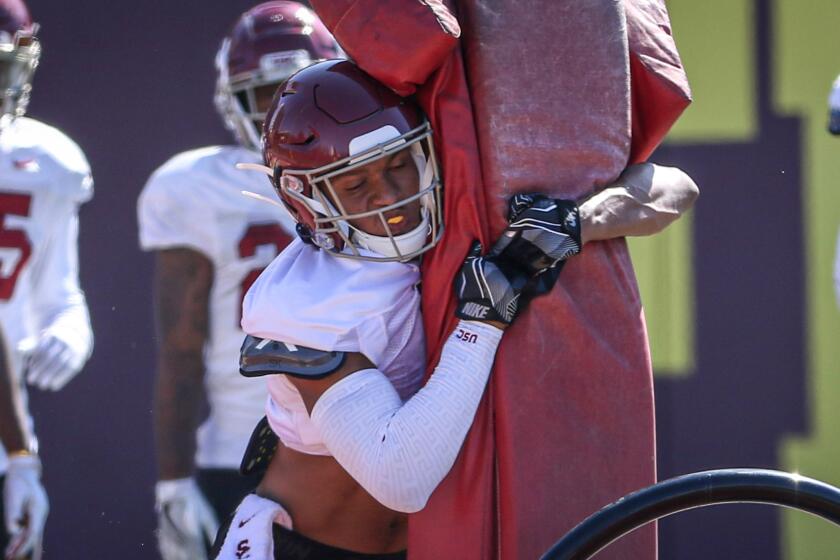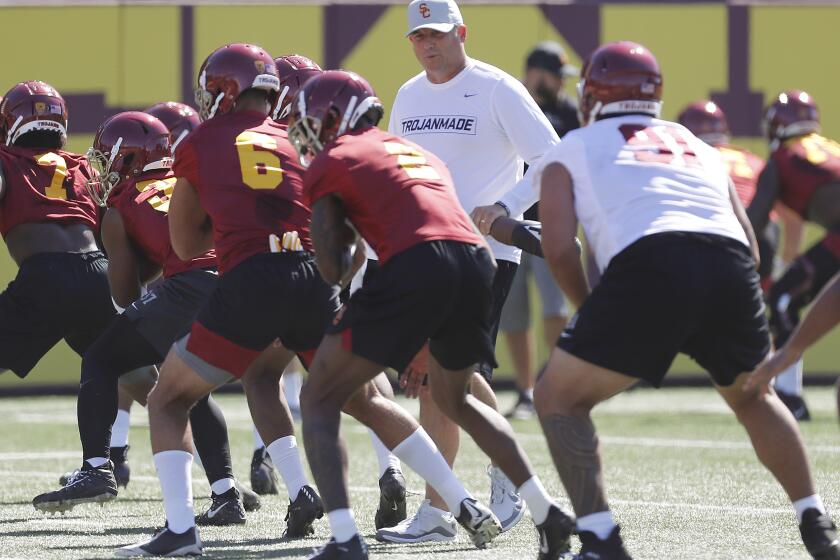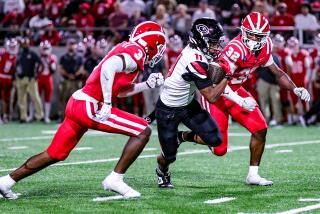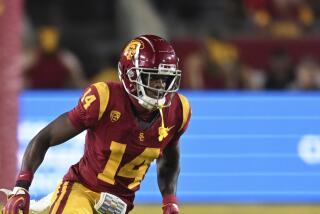Can’t catch? USC’s Markese Stepp is out to prove he can be an Air Raid threat
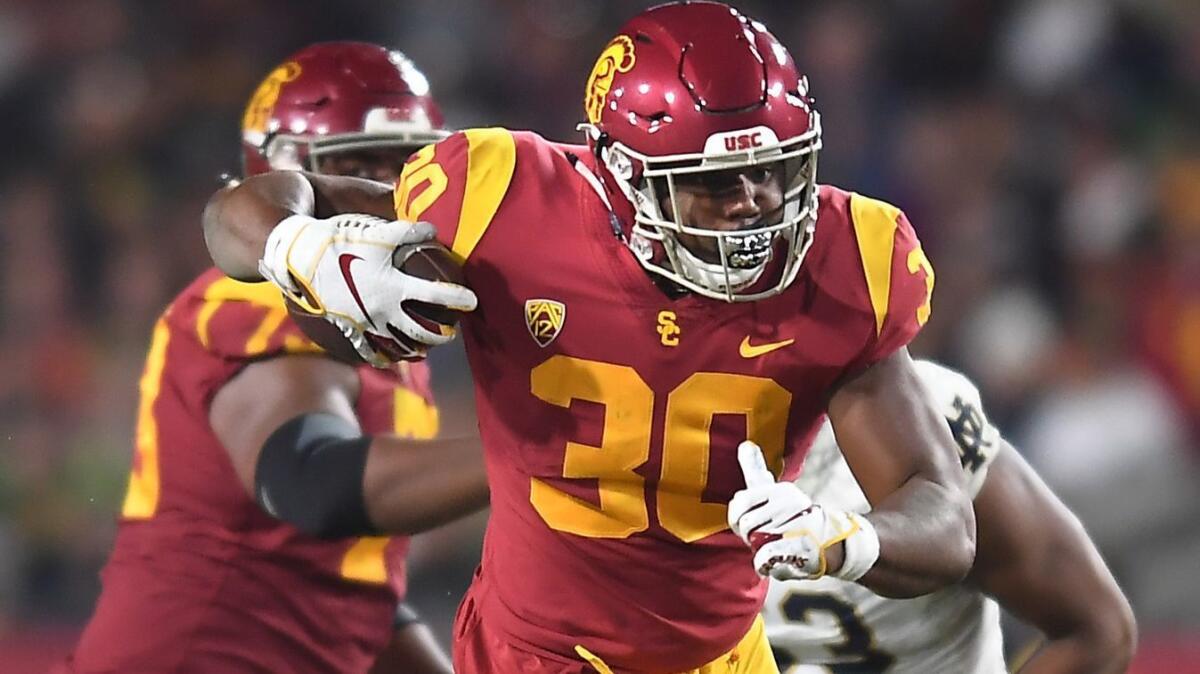
- Share via
Markese Stepp can’t catch. That’s what Mike Jinks was told.
As a disciple of the Air Raid offense, Jinks took close note of that intel upon his arrival at USC as the running backs coach.
Stepp had otherwise impressed in limited work a year ago during a redshirt season, routinely flashing the sort of dynamic, one-cut, power running style long favored by the Trojans.
But in a new system that demanded its running backs be all-purpose, three-down weapons, there were legitimate concerns about how a 230-pound battering ram rumored to have stone hands might fit.
Months later, thinking back on it, Jinks can’t help but laugh.
“We got lucky,” he said with a smile. “Nobody really knew that [Stepp] could catch like he can.”
As Jinks would later come to understand, nobody had ever asked. All of his life, Stepp had been a bruising, physical runner, so adept at barreling through contact that he did not need to master much else.
“In high school, I was bigger than some of the linemen,” Stepp recalled. “I guess I was always that type of running back.”
It was a perfect fit for Cathedral High in Indianapolis, where the pounding, pro-style rushing attack was a way of life. Not only could Stepp overwhelm defenses with his size, but his shiftiness often surprised unsuspecting defenders. It was a devastating combination, one that saw him emerge with 1,700 yards rushing as a sophomore despite splitting carries with a senior back.
Chris Steele and Isaac Taylor-Stuart are potential starters at cornerback for USC. Clay Helton hopes their skills will make up for their inexperience.
Major college programs took notice. Rick Streiff, his coach at Cathedral, remembers wondering that season whether Stepp might finish his career as the leading rusher in Indiana high school history. Then, the spring after his stellar sophomore campaign, Stepp’s hamstring seized up during a workout.
The injury lingered into the next season, and the next one after that. Stepp tried to play through it anyway, tearing off a touchdown run on one of his first carries as a junior.
But his touchdown sprint only aggravated the hamstring. He spent the next few months on the sideline, and when he returned for the postseason, Cathedral played him only in the red zone, so as to limit any potential breakaway runs.
“When we got down close, we put him in the game,” said Streiff, who’s now Cathedral’s athletic director. “It was almost like a pitcher with a pitch count.”
As a senior, Stepp ran for nearly 1,000 yards as the lead back in a committee at Cathedral. But most of the season was spent managing his health and limiting his carries.
“I just couldn’t get healthy,” Stepp said. “It was really hard to catch all the way back up.”
Which didn’t leave much time for Stepp to learn how to catch. He can count his high school reception totals with his two hands. Cathedral’s offense rarely called for him to even run an actual route.
“If there’s a little chink in the armor,” Streiff said, “I’d say probably his ball skills were not as good as they could be. But we just never asked him to do it.”
That won’t be the case at USC, where new offensive coordinator Graham Harrell’s version of the Air Raid demands that running backs be a threat out of the backfield. Over his last two seasons as offensive coordinator at North Texas, running backs accounted for 16% of the team’s receptions.
Now that the USC quarterback situation has been settled, coach Clay Helton is trying to make everyone happy.
Even before Harrell brought the Air Raid to L.A., Stepp understood his hands needed work. Last season, he realized he could no longer count on just plowing through defenders. He wanted to be a complete back.
But a reputation was already cemented when Jinks arrived in the offseason, and it was up to Stepp to prove that wrong. In a backfield crowded with talented backs, his hopes of emerging hinged on his hands improving.
So Stepp, who boasted just one career reception at USC, set about teaching himself to catch. He bounced a tennis ball against a wall over and over. He worked on a Jugs machine for hours every week. He caught passes after practice and ran routes wherever he could. Soon, coaches started to notice a difference.
“I’ll tell you where he’s progressed the most is catching the ball out of the backfield,” Trojans coach Clay Helton said of Stepp, who will maintain his status as a freshman because he only played in four games last season. “He realized coming into this system that that was part of the deal, and he did a really nice job.”
His work as a receiver has only just begun. When it comes to catching passes, Stepp is still the most raw option in USC’s stable of running backs.
But none of those other backs is quite capable of what Stepp does at his best. During a recent scrimmage, on fourth down at the goal line, he offered a reminder. Bursting forward with the handoff, Stepp lowered a shoulder into linebacker Ralen Goforth, who bounced backward off him into the end zone.
That power was why Stepp wound up at USC in the first place. But with a new season ahead and a new offense in place, the battering ram who couldn’t catch has the chance to be much more.
More to Read
Go beyond the scoreboard
Get the latest on L.A.'s teams in the daily Sports Report newsletter.
You may occasionally receive promotional content from the Los Angeles Times.

